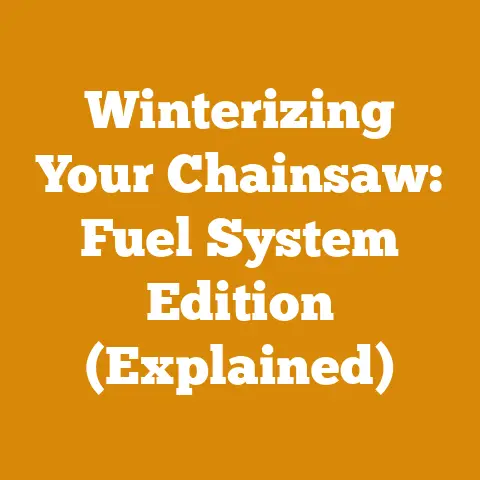Chainsaw Fuel Line Blues: Diagnosing and Fixing (Explained)
Why Proper Fuel Line Maintenance Matters
The fuel line is a critical but often overlooked component.
It transports gasoline from the fuel tank to the carburetor, where it is mixed with air to power the engine.
When fuel lines become cracked or obstructed, several problems can occur:
- Engine won’t start or stalls shortly after starting
- Loss of power when cutting
- Increased difficulty starting when hot
- Excessive flooding or leakage of fuel
Dirty or clogged fuel filters can also mimic fuel line problems.
Thankfully, fuel lines and filters are inexpensive parts that are easy to replace yourself.
Proper maintenance can get your chainsaw running like new again.
Diagnosing Fuel Line Issues
The first step is confirming that the issue is related to the fuel line.
Here are some diagnostic tips:
Check for visible cracks or damage – Examine fuel lines for cracking, dry rot, blockages, or separation from fittings.
Damage is often visible near fittings.
Listen for air being sucked into fuel line – With the chainsaw running, listen near the fuel line and carburetor for hissing noises, which indicate an air leak.
Do a quick fuel line inspection – Disconnect the line between the tank and carburetor.
Blow through it to check for blockages.
Perform this away from any ignition sources!
Check fuel flow to carburetor – Disconnect fuel line from carburetor and crank engine.
Fuel should flow freely.
No fuel likely indicates line blockage.
Consider other potential causes – Fuel line issues can resemble problems with the spark plug, carburetor, or ignition system.
Rule these out first.
If your diagnostics point to a fuel system problem, replacing the line and/or filter is the best solution.
Replacing Fuel Lines – Step-by-Step
Here are step-by-step instructions for replacing chainsaw fuel lines:
Section 1 – Prepare the Chainsaw
Before getting started, gather the necessary replacement parts and tools:
- Fuel line kit (contains lines, filters, clamps, grommets)
- Wire cutters or knife (to cut fuel line)
- Needle nose pliers (to clamp line and manipuate fittings)
- Small flathead screwdriver (to assist disconnecting old line)
Next, empty the chainsaw of all fuel.
This reduces fire risk during the repair.
Consult your owner’s manual on how to drain the tank, run the engine dry, and remove ignition sources.
Once emptied of fuel, disconnect the spark plug wire.
This prevents accidental startup while working on the fuel system.
Finally, clean the area around the fuel tank, carburetor, and air filter housing.
Remove air filter and pre-filter to allow access to the carburetor intake.
Section 2 – Remove the Old Fuel Line
With the chainsaw prepped, you can begin removing the old fuel line:
- Locate where the fuel line connects to the fuel tank nipple and carburetor inlet
- Use pliers to loosen and slide back any clamps or clips at both ends
- Carefully cut the fuel line in the middle using wire cutters or a knife
- Apply pressure with pliers or screwdriver to detach the fuel line at both ends
Examining the old fuel line, check for cracks, hard sections, or obstructions that may have caused issues.
Check the inner wall of the fuel tank for sediment buildup as well.
Section 3 – Install New Fuel Line and Filter
Once the old fuel line is fully removed, you can install the new components:
- Slide a new fuel filter over one end of the replacement fuel line
- Push the fuel line end firmly over the carburetor fuel inlet nipple
- Secure with a clamp or small hose clamp using pliers
- Route the line toward the fuel tank following any guide grooves
- Attach the other end firmly over the fuel tank outlet nipple
- Secure with another clamp or clip
Ensure both ends are securely attached.
Position the fuel filter between the fuel tank and carburetor per your chainsaw’s specifications.
Install new grommets if provided with the replacement kit.
Section 4 – Reattach Components and Test for Leaks
With the new fuel line installed, reattach other components:
- Reinstall air filter, pre-filter, and any housing covers removed earlier
- Reconnect spark plug wire
- Refill chainsaw fuel tank with fresh fuel/oil mix
- Restart chainsaw and check for fuel leaks at connections
Let the chainsaw fully warm up, then operate the throttle and test for consistent performance.
The new fuel line should restore smooth operation.
Finally, safely dispose of any spilled fuel and the old degraded fuel line.
Your chainsaw should now be back to full power!
Preventing Future Fuel Line Problems
With a fresh fuel line installed, here are some tips to maximize its lifespan and avoid future issues:
Use ethanol-free gas – Ethanol attracts moisture and can accelerate degradation of fuel lines.
When possible, use pure gasoline without ethanol.
Install quality fuel line – Invest in OEM or premium aftermarket fuel line.
Avoid cheap imitation parts.
Check fittings occasionally – Periodically inspect where the line connects to the fuel tank and carburetor for leaks.
Replace old fuel – Don’t leave stale gasoline sitting for months.
Cycle it every 2-4 weeks to limit varnish deposits.
Clean the fuel tank – Over time, rust and sediment accumulate internally.
Periodically drain and clean the tank.
Follow storage best practices – Before extended storage, add fuel stabilizer and run the engine dry to avoid internal corrosion issues.
Proper preventative care reduces the frequency of needed repairs and keeps your chainsaw running strong when you need it most.
Be sure to consult your owner’s manual for model-specific fuel system maintenance recommendations.
With some basic tools and diagnosis, fixing common chainsaw fuel line problems is usually a straightforward process.
Paying attention to fuel system health helps maximize performance and minimizes frustration when that tree comes crashing down.
Share this guide with fellow chainsaw owners facing similar issues, so their equipment can get back to peak condition.




